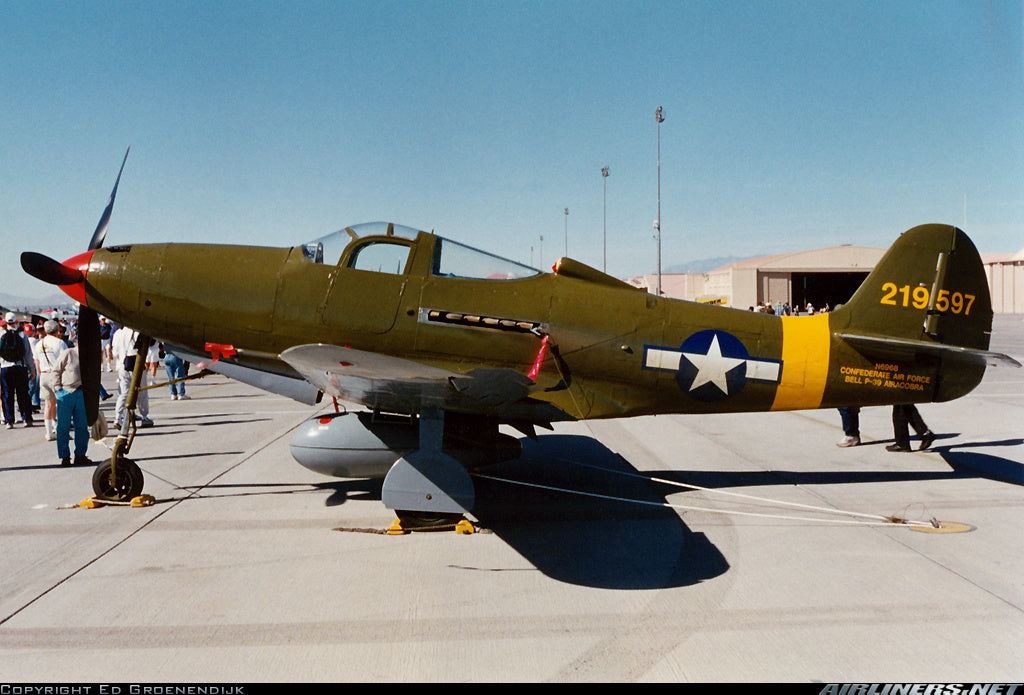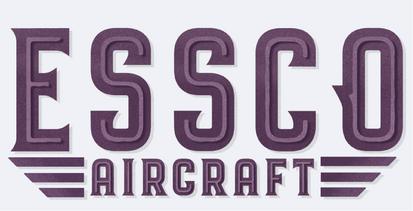
Number 44 of 100 in 100, the Bell P-39 Airacobra
Conceptualization:
The Bell P-39 Airacobra was conceived in response to a growing demand for high-performance fighters in the late 1930s. Aviation was rapidly advancing, and military pilots were looking for aircraft that could not only outpace but also outgun their adversaries. The U.S. Army Air Corps issued specifications in 1937 calling for an aircraft capable of high-altitude interception. Bell Aircraft's designers, set out to create an innovative fighter that could meet this requirement. Their bold solution included an engine installed in the center fuselage that allowed space in the nose for a powerful 37 mm cannon, enhancing the aircraft's ground-attack capabilities. The aircraft’s tricycle landing gear and powerful armament appealed to pilots and were well-suited to the military's growing focus on multi-role aircraft.
Original Design:
The Bell P-39 Airacobra featured several innovative design elements, starting with its unique mid-engine configuration. This layout placed the Allison V-1710 engine behind the cockpit, allowing for better weight distribution. Another standout feature was its tricycle landing gear, one of the first for American fighters, which improved ground handling and made landings easier for pilots. The armament configuration was another key element, with two .50 caliber machine guns in the nose and two or four .30 caliber guns in the wings. However, the removal of the turbo-supercharger limited the aircraft's performance at high altitudes. The P-39 found success in low-altitude combat and ground attack roles, particularly in the hands of Soviet pilots, who used it extensively during World War II.

Photo Credit: airliners.net - Andreas Kauert
Principal Designer:
The project leader of the Bell P-39 Airacobra was Robert J. Woods, Bell Aircraft's chief engineer. Woods had a background in aerodynamics and aircraft engineering, which positioned him to lead the development of one of the most unique fighters of World War II. H.M. Poyer was also involved in the Bell P-39 Airacobra project. He was a designer working directly under Woods. Poyer played a significant role in the design of the P-39, particularly for advocating for the incorporation of the nose-mounted 37 mm cannon. Woods' and Poyer’s innovative designs helped shape Bell Aircraft’s contributions to military aviation during the war.
Production Run:
The Bell P-39 Airacobra entered production in 1939, following the completion of its prototype testing. Full-scale production began in 1940, and the aircraft was produced until August 1944. A total of 9,588 units were built during this time, making it one of the most-produced American fighters of World War II. Production remained steady throughout the war, but as newer aircraft like the P-51 Mustang became available, demand for the P-39 declined in the U.S. Despite its limited high-altitude performance, the P-39 found success in roles that included ground attack and close air support.
Evolution:
The Bell P-39 Airacobra went through significant evolution during its production run, with several variants reflecting ongoing improvements. The P-39C model was quickly replaced by the P-39D, which added self-sealing fuel tanks and additional armor to improve pilot survivability. One of the most notable variants was the P-39Q, the most-produced version, which featured underwing pylons for bombs or fuel tanks and an upgraded armament with wing-mounted .50 caliber machine guns. The aircraft’s role also evolved, shifting from a high-altitude interceptor to a ground-attack fighter and low-altitude dogfighter.

Photo Credit: airliners.net - Karl Drage
Specifications:
General characteristics
- Crew: One
- Length: 30 ft 2 in (9.19 m)
- Wingspan: 34 ft 0 in (10.36 m)
- Height: 12 ft 5 in (3.78 m)
- Wing area: 213 sq ft (19.8 m2)
- Empty weight: 6,516 lb (2,956 kg)
- Gross weight: 7,570 lb (3,434 kg)
- Max takeoff weight: 8,400 lb (3,810 kg)
- Powerplant: 1 × Allison V-1710-85 V-12 liquid-cooled piston engine, 1,200 hp (890 kW) at 9,000 ft (2,743 m) (emergency power)
- Propellers: 3-bladed constant-speed propeller
Performance
- Maximum speed: 389 mph (626 km/h, 338 kn)
- Stall speed: 95 mph (153 km/h, 83 kn) power off, flaps and undercarriage down
- Never Exceed Speed: 525 mph (845 km/h, 456 kn)
- Range: 525 mi (845 km, 456 nmi) on internal fuel
- Service ceiling: 35,000 ft (11,000 m)
- Rate of climb: 3,805 ft/min (19.33 m/s) at 7,400 ft (2,300 m) (using emergency power)
- Time to altitude: 15,000 ft (4,600 m) in 4 minutes 30 seconds, at 160 mph (260 km/h)
- Wing loading: 34.6 lb/sq ft (169 kg/m2)
- Power/Mass: 0.16 hp/lb (0.26 kW/kg)
Armament
- Guns:
- 1 × 37 mm M4 cannon firing through the propeller hub
- 2 × .50 caliber synchronized Browning M2 machine guns, nose-mounted
- 2 × .50 caliber Browning M2 machine guns one each wing
- Bombs: Up to 500 lb (230 kg) of bombs under wings and belly
In Comparison to Other Aircraft in Its Class:
The Bell P-39 Airacobra, when compared to other fighters, offers a mix of strengths and limitations. Against the Supermarine Spitfire Mk Vb, the P-39 had a comparable top speed of 389 mph, but the Spitfire's armament and precision made it superior in dogfights. The Spitfire also excelled at high altitudes with a ceiling of 36,500 feet, while the P-39 struggled without a turbo-supercharger, limiting it to lower-altitude roles. In comparison to the Messerschmitt Bf 109G, the P-39 was slightly slower and had less balanced armament for air-to-air combat, though its 37 mm cannon gave it an advantage in ground attacks. The Bf 109G's supercharged engine also made it better suited for high-altitude engagements. When compared to the Curtiss P-40 Warhawk, the P-39 had a slight speed advantage and a more powerful cannon for ground targets, though both aircraft were better suited to low-altitude missions due to the lack of turbo-superchargers. Ultimately, the P-39 found success as a low-altitude fighter and ground-attack aircraft. However, its high-altitude limitations meant it couldn’t compete with fighters like the Spitfire and Bf 109 in those environments. Despite this, the P-39's heavy armament made it a valuable asset in ground-attack roles.
Performance:
Bell P-39 Airacobra: Performance Envelope for Pilots
V-Speeds:
- Vne (Never Exceed Speed): 525 mph (845 km/h, 456 kn)
- Vmax (Maximum Speed): 389 mph (626 km/h, 338 kn)
- Vno (Maximum Structural Cruising Speed): 350 mph (563 km/h) IAS
- Vle (Maximum Landing Gear Extended Speed): 150 mph (241 km/h)
- Vlo (Maximum Landing Gear Operation Speed): 140 mph (225 km/h)
- Vfe (Maximum Flap Extended Speed): 150 mph (241 km/h)
- Va (Maneuvering Speed): Approximately 270 mph (435 km/h)
G-Load Limitations:
- Positive G-Limit: +8.5 G
- Negative G-Limit: -3.5 G
In Comparison to Other Aircraft in Its Class:
The P-39's G-load limitations allowed it to handle aggressive maneuvers like high-speed dives, tight turns, and spin recoveries, though pilots had to be careful not to overstress the airframe during sustained high-G situations. Approved maneuvers included loops, barrel rolls, aileron rolls, Immelmann turns, Split-S maneuvers, chandelles, wingovers, lazy eights, and steep turns. While agile, the P-39's center-mounted engine required precise control, especially in low-speed, high-angle maneuvers, as its heavy nose could induce spins that were not always easy to recover from. It was primarily used for advanced combat training, particularly for low-altitude and ground-attack missions, where its handling quirks and powerful armament were valuable. Its tricycle landing gear provided improved ground handling for new pilots, though its overall complexity meant it was not suitable for novice pilots without extensive training. The P-39 remains popular among warbird enthusiasts and collectors for airshow demonstrations. In combat, the P-39 excelled in ground-attack roles due to its armament and low-altitude agility, and it was a useful advanced training platform for transitioning pilots.

Photo Credit: airliners.net - John Myers
Safety Record:
The safety record of the Bell P-39 Airacobra was mixed, largely due to its unique design and handling characteristics. One of the main concerns was its tendency to enter flat spins during high-angle-of-attack maneuvers, which were difficult to recover from. Pilots needed specific training to manage these spins, and inexperienced pilots were more prone to accidents. The aircraft's mid-engine layout also posed vulnerabilities, particularly in combat, as hits to the fuselage could disable the engine. Its lack of high-altitude performance, due to the removal of the turbo-supercharger, further limited its effectiveness and safety in high-altitude dogfights. Compared to other fighters like the P-51 Mustang or the Spitfire, the P-39’s safety record was less favorable, though it performed well in low-altitude and ground-attack roles.
Acquisition Cost:
The original acquisition cost of the Bell P-39 Airacobra was $50,666 per unit in 1944. That would equate to roughly $850,000 today. While the original cost was substantial at the time, the aircraft was relatively affordable compared to modern military aircraft. Only a few P-39s remain in flying condition, which limits the availability for acquisition in today’s world.
Conclusion:
The Bell P-39 Airacobra stands as a unique and innovative aircraft that played a significant role in World War II, despite its design limitations. Its mid-engine configuration, heavy armament, and tricycle landing gear were pioneering features that made it effective in ground-attack roles and low-altitude combat. Although it faced challenges such as poor high-altitude performance and a tendency to enter spins, the P-39's rugged design and adaptability helped secure its place in aviation history. With nearly 9,588 units produced, the P-39 made its mark, proving that innovation can lead to success even when it veers from conventional norms.

Photo Credit: airliners.net - Simon Thomas
Bibliography:
Bell P-39 Airacobra - Wikipedia
National Museum of the U.S. Air Force
Airliners.net – Bell P-39 Airacobra
Military Factory – Bell P-39 Airacobra
Essco Links:
